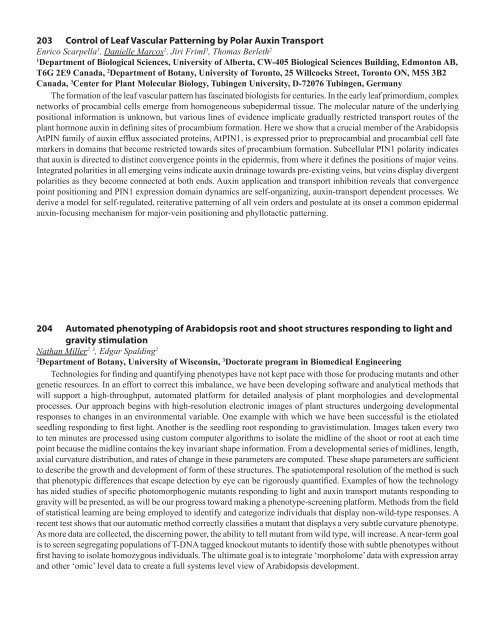75 Integrating Membrane Transport with Male Gametophyte ... - TAIR
75 Integrating Membrane Transport with Male Gametophyte ... - TAIR
75 Integrating Membrane Transport with Male Gametophyte ... - TAIR
Create successful ePaper yourself
Turn your PDF publications into a flip-book with our unique Google optimized e-Paper software.
203 Control of Leaf Vascular Patterning by Polar Auxin <strong>Transport</strong><br />
Enrico Scarpella 1 , Danielle Marcos 2 , Jiri Friml 3 , Thomas Berleth 2<br />
1<br />
Department of Biological Sciences, University of Alberta, CW-405 Biological Sciences Building, Edmonton AB,<br />
T6G 2E9 Canada, 2 Department of Botany, University of Toronto, 25 Willcocks Street, Toronto ON, M5S 3B2<br />
Canada, 3 Center for Plant Molecular Biology, Tubingen University, D-72076 Tubingen, Germany<br />
The formation of the leaf vascular pattern has fascinated biologists for centuries. In the early leaf primordium, complex<br />
networks of procambial cells emerge from homogeneous subepidermal tissue. The molecular nature of the underlying<br />
positional information is unknown, but various lines of evidence implicate gradually restricted transport routes of the<br />
plant hormone auxin in defining sites of procambium formation. Here we show that a crucial member of the Arabidopsis<br />
AtPIN family of auxin efflux associated proteins, AtPIN1, is expressed prior to preprocambial and procambial cell fate<br />
markers in domains that become restricted towards sites of procambium formation. Subcellular PIN1 polarity indicates<br />
that auxin is directed to distinct convergence points in the epidermis, from where it defines the positions of major veins.<br />
Integrated polarities in all emerging veins indicate auxin drainage towards pre-existing veins, but veins display divergent<br />
polarities as they become connected at both ends. Auxin application and transport inhibition reveals that convergence<br />
point positioning and PIN1 expression domain dynamics are self-organizing, auxin-transport dependent processes. We<br />
derive a model for self-regulated, reiterative patterning of all vein orders and postulate at its onset a common epidermal<br />
auxin-focusing mechanism for major-vein positioning and phyllotactic patterning.<br />
204 Automated phenotyping of Arabidopsis root and shoot structures responding to light and<br />
gravity stimulation<br />
Nathan Miller 2, 3 , Edgar Spalding 2<br />
2<br />
Department of Botany, University of Wisconsin, 3 Doctorate program in Biomedical Engineering<br />
Technologies for finding and quantifying phenotypes have not kept pace <strong>with</strong> those for producing mutants and other<br />
genetic resources. In an effort to correct this imbalance, we have been developing software and analytical methods that<br />
will support a high-throughput, automated platform for detailed analysis of plant morphologies and developmental<br />
processes. Our approach begins <strong>with</strong> high-resolution electronic images of plant structures undergoing developmental<br />
responses to changes in an environmental variable. One example <strong>with</strong> which we have been successful is the etiolated<br />
seedling responding to first light. Another is the seedling root responding to gravistimulation. Images taken every two<br />
to ten minutes are processed using custom computer algorithms to isolate the midline of the shoot or root at each time<br />
point because the midline contains the key invariant shape information. From a developmental series of midlines, length,<br />
axial curvature distribution, and rates of change in these parameters are computed. These shape parameters are sufficient<br />
to describe the growth and development of form of these structures. The spatiotemporal resolution of the method is such<br />
that phenotypic differences that escape detection by eye can be rigorously quantified. Examples of how the technology<br />
has aided studies of specific photomorphogenic mutants responding to light and auxin transport mutants responding to<br />
gravity will be presented, as will be our progress toward making a phenotype-screening platform. Methods from the field<br />
of statistical learning are being employed to identify and categorize individuals that display non-wild-type responses. A<br />
recent test shows that our automatic method correctly classifies a mutant that displays a very subtle curvature phenotype.<br />
As more data are collected, the discerning power, the ability to tell mutant from wild type, will increase. A near-term goal<br />
is to screen segregating populations of T-DNA tagged knockout mutants to identify those <strong>with</strong> subtle phenotypes <strong>with</strong>out<br />
first having to isolate homozygous individuals. The ultimate goal is to integrate ‘morpholome’ data <strong>with</strong> expression array<br />
and other ‘omic’ level data to create a full systems level view of Arabidopsis development.





